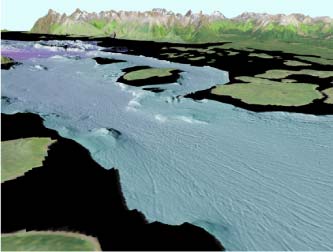 Introduction Introduction
Glacier Bay is a diverse fjord ecosystem with multiple tidewater glaciers and complex biological, geological, and oceanographic patterns that vary greatly along its length. The bay was completely glaciated prior to the 1700's, and subsequently experienced the fastest glacial retreat recorded in historical times. As a result, some of the highest rates of glacial sedimentation and uplift are observed here.
Glacier Bay is the deepest silled fjord in Alaska, with depths of over 450 meters. The variety of physical processes and depths creates many diverse habitats within a relatively small area. Mapping benthic (seafloor) habitats is thus crucial to understanding and managing Glacier Bay's complex marine ecosystem and the marine species therein. High-resolution multibeam mapping of the bay, funded jointly by USGS and the National Park System, provides an unprecedented new baseline for resource and habitat assessment. Full integration of the new data set will require additional ground-truthing data (sampling) and analysis. The USGS goal is to develop integrated geological and oceanographic habitat models for the marine benthos in Glacier Bay, as a step toward determining the habitat relationships of critical species and resources within the Park.
|
Last modified October 16, 2006
Part or all of this report is presented in Portable Document Format (PDF). For best results viewing and printing PDF documents, it is recommended that you download the documents to your computer and open them with Adobe Reader. PDF documents opened from your browser may not display or print as intended. Download the latest version of Adobe Reader, free of charge.
|